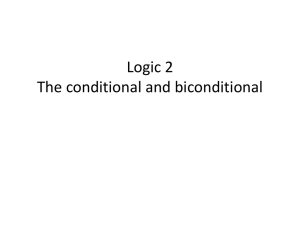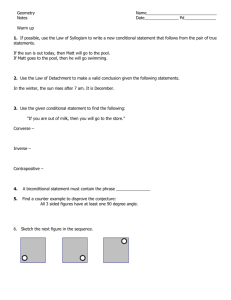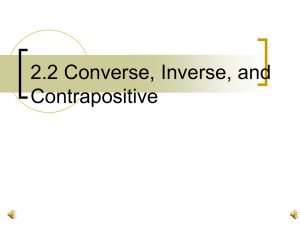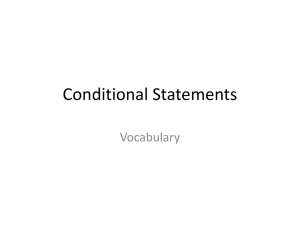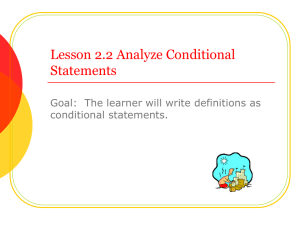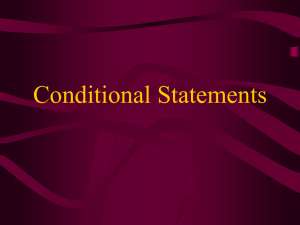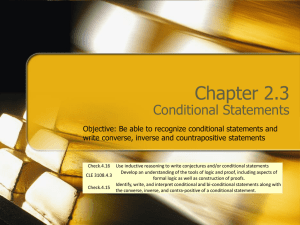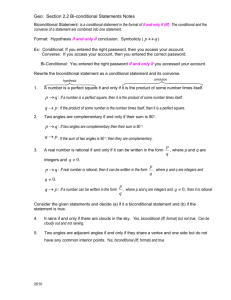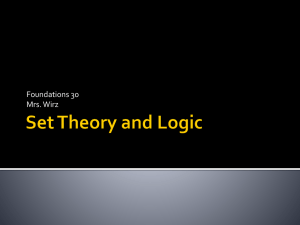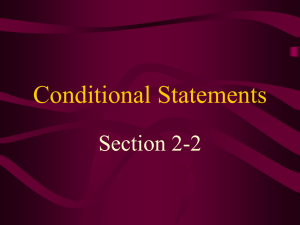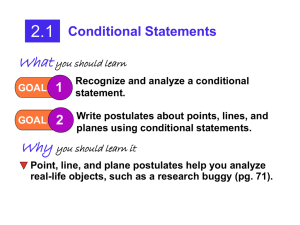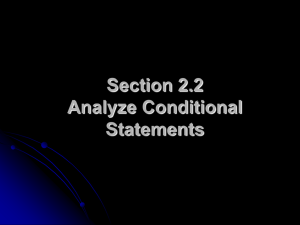Conditional Statements
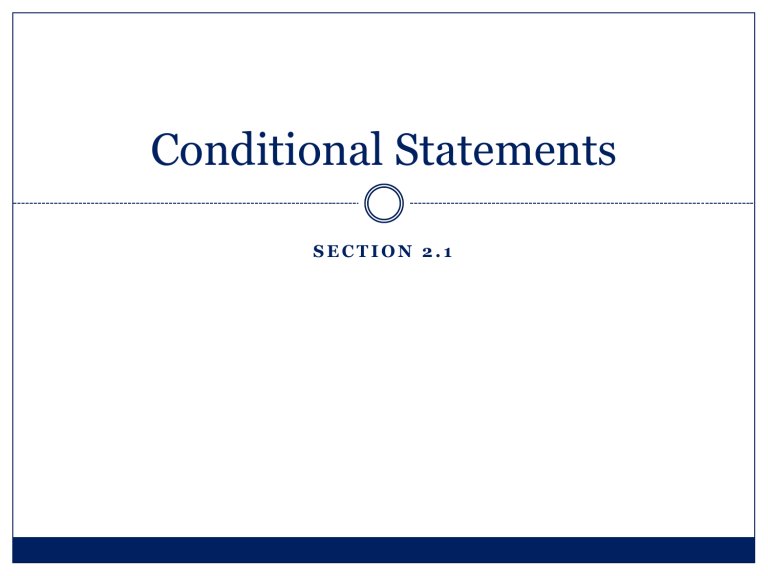
Conditional Statements
S E C T I O N 2 . 1
Learning Outcomes
I will be able to write conditional statements in ifthen form.
I will be able to label parts of a conditional statement.
I will be able to write the converse, inverse and contrapositive of a conditional statement.
Vocabulary
A conditional statement is a type of logical statement that has two parts, a hypothesis and a conclusion.
If-then form of a conditional statement uses the words “if” and “then.”
Example: If today is Friday, then tomorrow is
Saturday.
Parts of a Conditional Statement
A hypothesis is the “if” part of a conditional statement.
A conclusion is the “then” part of a conditional statement.
In our example:
If today is Friday, then tomorrow is Saturday.
Think-Pair-Share
Write the statement as a conditional statement in ifthen form.
All students taking geometry have math during an even numbered block.
If students are taking Geometry, then they have math during an even numbered block.
Converse
The converse of a conditional statement is formed by switching the hypothesis and the conclusion.
From our example: If today is Friday, then tomorrow is Saturday.
The converse would be: If tomorrow is Saturday, then today is Friday.
Inverse
An inverse is the statement formed when you negate the hypothesis and conclusion of a conditional statement.
What is a negation?
The negation of a statement is formed by writing the negative of the statement.
In our example: If today is Friday, then tomorrow is
Saturday.
The inverse would be: If today is not Friday, then tomorrow is not Saturday.
Contrapositive
A contrapositive is the statement formed when you negate the hypothesis and conclusion of the converse of a conditional statement.
In our example: If today is Friday , then tomorrow is
Saturday .
The contrapositive would be: If tomorrow is not
Saturday, then today is not Friday.
In Review
Original Statement: If today is Friday, then tomorrow is Saturday
Converse: If tomorrow is Saturday, then today is
Friday
Inverse: If today is not Friday, then tomorrow is not
Saturday.
Contrapositive: If tomorrow is not Saturday, then today is not Friday.
Random Postulates
Review
Write the converse of this statement
I will go to the game if I get all of my homework done.
Converse: If I go to the game, then I got all of my homework done.
Review
Write the inverse of this statement:
I will go to the game if I get all of my homework done.
Inverse: If I do not get all my homework done, then I will not go to the game
Review
Write the contrapositive of this statement:
I will go to the game if I get all of my homework done.
Contrapositive: If I do not go to the game, then I did not get all my homework done.
Biconditionals and Laws
S E C T I O N 2 . 2
Outcomes
I will be able to write biconditional statements if the properties for a biconditional statement exist
Biconditional Statements
A biconditional statement is a statement that contains the phrase “if and only if.”
For a biconditional statement to be true, you must:
Verify that the conditional statement is true.
Verify that the converse of the statement is true.
Rewriting Biconditional Statements
Rewrite the biconditional statement as a statement and its converse.
Two angles are congruent if and only if they have the same measure.
If two angles have the same measure, then they are congruent.
Converse:If two angles are congruent, then they have the same measure.
Evaluating Biconditional statements
Is the following biconditional statement true?
Two angles are congruent if and only if they have the same measure.
If two angles have the same measure, then they are congruent.
Converse:If two angles are congruent, then they have the same measure.
Evaluate the biconditional statement to see if it is true.
x = 4 if and only if x 2 = 16.
If x = 4, then x 2 = 16
If x 2 = 16, then x = 4.
Can the statement be written as a biconditional?
Example: If you are 15 years old, then you are a teenager.
First, evaluate the statement. Is it true?
Second, write the converse of the statement.
Third, evaluate the converse. Is it true?
Converse: If you are a teenager, then you are 15 years old.
Definitions
Two lines are perpendicular lines if they intersect to form a right angle.
Definitions
A line perpendicular to a plane is a line that intersects the plane in a point and is perpendicular to every line in the plane that intersects it.
Exit Ticket Homework
Pg. 75: 22-24, 44-49
Pg. 83: 13-23, 32-35
